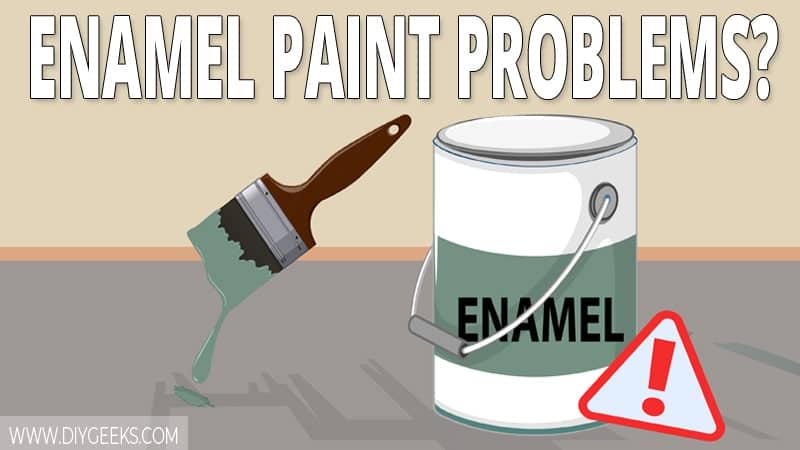Enamel paint is oil-based and has a thick flow; because of that, you will face different problems before, while, and after applying it. Most of the problems are caused by improper surface preparation or paint.
Enamel paint issues and their fixes are listed below.
1. How To Fix Wrinkled Enamel Paint?
To fix wrinkled enamel paint, do the following.
- Use a paint scraper to scrape the wrinkled enamel paint.
- Sand the surface to remove the paint.
- Smoothen the surface with fine-grit sandpaper.
- Wipe and clean the dust off the surface.
- Apply a stain-blocking primer.
- Re-apply paint.
Enamel paint develops wrinkles if the paint doesn’t fully dry before you use or clean it. Paint wrinkles are developed if the top layer dries, while the underneath paint is still wet. They start as single irregular lines then start to link and form a web of wrinkles over the paint finish.
Other reasons why paint wrinkles occur are listed below.
- Cold Weather – If you apply paint at cold temperatures, the paint will start to contract until it forms wrinkles.
- Thick Coats – Since enamel paint is oil-based, its coating has many oily deposits. If you apply thick coats, the coating will have too many oils and take longer to dry. Since the paint remains wet for a few hours, the finish will develop wrinkles.
If you paint over wrinkled enamel paint with another coat, the new coat will also develop wrinkles.
2. How To Fix Bubbles in Enamel Paint?
To fix bubbles in enamel paint, do the following.
- Pop the bubbles in the paint.
- Leave the paint to dry.
- Sand the surface with fine-grit sandpaper.
- Touch up the surface by applying two enamel paint coats.
- Allow the paint to dry.
- Smooth the surface with fine-grit sandpaper.
Note: If the bubbles are caused by improper surface preparation, you must remove the enamel paint, fix the surface (check for water leaks), and re-apply the paint.
Enamel paint develops bubbles if air gets trapped between coats while applying it. Once the paint dries, the trapped air will form bubbles and might cause tiny holes in the finish.
Other reasons why enamel paint finish forms bubbles are listed below.
- Stirred Too Hard – Since enamel paint is thick, it’s common to thin it before applying it. However, air pockets will get trapped in the coating if you stir too hard or fast while thinning it. So, once you apply the paint, these trapped air pockets will form bubbles in the finish.
- Porous Surface – Porous surfaces, such as fresh wood, have many pores. Sometimes, the air gets trapped inside the wood pores, so once you apply paint, the trapped air will cause bubbles in the finish. To prevent this, you must apply a stain-blocking primer before painting.
- Wet Surface – If you apply enamel paint over a wet surface, the paint adhesion will be weak. Since there’s poor adhesion between the paint and the surface, air can get underneath the coating and cause bubbles.
3. How to Fix Sticky Enamel Paint?
To fix sticky enamel paint, do the following.
- Open all windows and doors to increase airflow.
- Use a hairdryer to increase the heat around the coating so it dries faster.
- Use a dehumidifier to reduce the moisture in the atmosphere.
- Turn on the fans in the room.
Enamel paint turns sticky if you re-coat it too soon, you apply too many coats, the temperature is low and humidity is high, or the surface is wet.
If you re-coat enamel paint too soon, the paint solvent will get trapped between two coatings and prevent the old and new coating from drying, leading to a sticky or tacky finish.
If the paint remains sticky for several days, there’s a problem with the surface. To fix it, do the following things.
- Dissolve the enamel paint with mineral spirits.
- Use a paint scraper to scrape off the paint.
- Find and fix problems with the surface (such as a water leak).
- Apply two coats of a moisture-resistant primer paint
- Re-apply the paint and allow it to dry.
4. How To Fix Enamel Paint Turning Yellow?
You can’t fix yellowing enamel paint since the cause of the yellowing is in the formula of the paint. However, to reduce the yellow tint, do the following things.
- Apply light coats so there are fewer oily deposits on the surface.
- Thin enamel paint before applying it.
- Sand the yellowing spots with fine-grit sandpaper as soon as they appear.
Oil-based enamel paint turns yellow because of its high volume of natural (or synthetic) oils in the formula. The paint will leave behind oily deposits on the surface while drying. These oily deposits will start to yellow tiny spots, and these spots will gradually spread until the paint coating develops a yellow or amber-like color shade.
5. How to Fix Cracking Enamel Paint?
To fix cracking enamel paint, do the following things.
- Remove the paint finish.
- Fix any issues with the surface or material.
- Sand the surface.
- Apply paint primer.
- Re-apply enamel paint.
Enamel paint finish cracks (or splits) if the paint dries too fast, if you over-thin the paint, if you re-coated too soon, or because of surface issues.
If the paint dries too fast, the paint particles don’t have enough time to harden naturally, so the bond between them will be weak, and the finish cracks. The paint cracks start small, but as time goes by, the cracks get bigger and allow air to get underneath the paint and peel it off.
Enamel paint can develop hairline cracks if you over-thin the paint. That’s because the coat will be too thin and crack under minimal contact.


